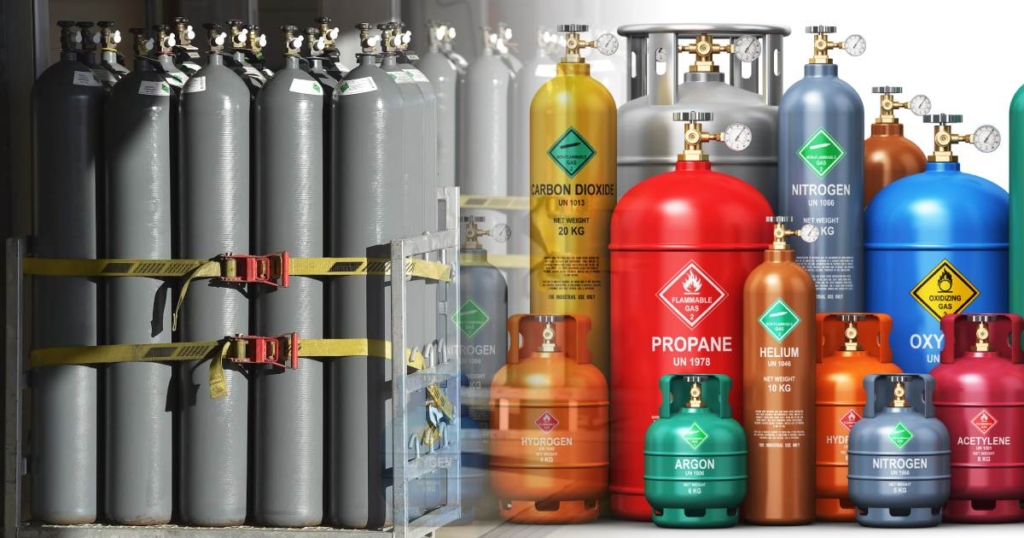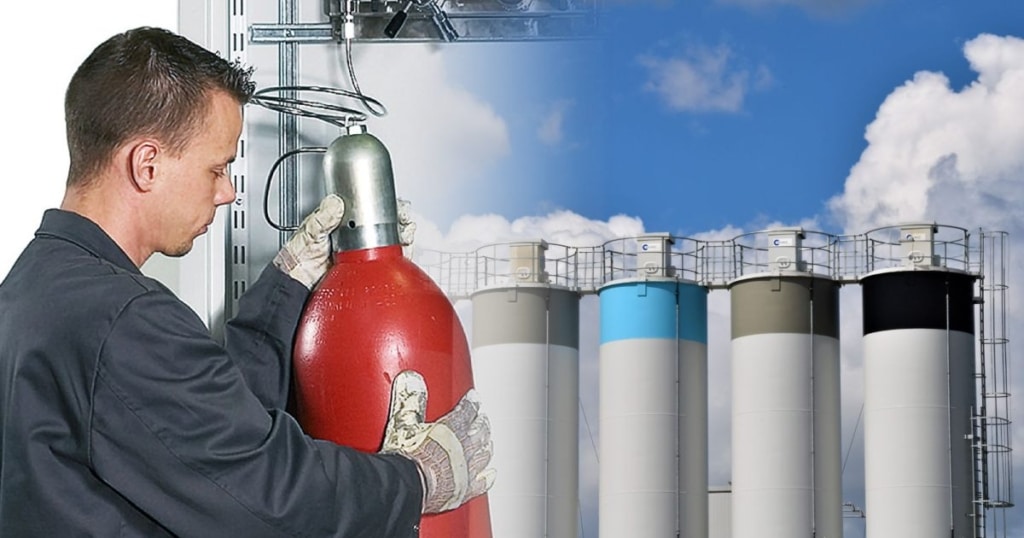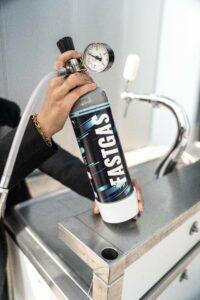Industrial Gas Cylinders: Safety and Handling Best Practices
FastGas Blog
Industrial gas cylinders are a cornerstone of numerous industries, providing the essential gases needed for a wide range of applications. From manufacturing to healthcare, these cylinders store and transport gases such as oxygen, nitrogen, carbon dioxide, and argon, which are critical in processes ranging from welding to preserving food. They come in various sizes and specifications, catering to different requirements. Safe handling and storage of these cylinders are paramount because they contain gases at high pressures, and any misuse can lead to serious safety hazards.
Before acquiring industrial gas cylinders for your operations, it’s important to understand the diverse types and their uses. Suppliers offer a spectrum of options for small-scale applications requiring portable cylinders or larger needs met by high-capacity cylinder packs. The procurement process often involves considering whether to rent or purchase cylinders, and understanding your supply needs is crucial for cost-effective and efficient operations.
Key Takeaways
- Industrial gas cylinders are vital for a multitude of applications across different sectors.
- There’s a broad selection of cylinder types and sizes to meet varied industrial needs.
- Safety and informed procurement are critical when dealing with industrial gases and their cylinders.
Types and Uses of Industrial Gas Cylinders
Industrial gas cylinders are critical components in a wide range of industries, serving purposes from manufacturing to healthcare. These containers safely store and transport numerous gases for various applications, with diverse compositions and sizes tailored to specific uses.
Common Industrial Gases and Their Applications
Industrial cylinders typically house atmospheric gases like nitrogen and oxygen, which are used in processes such as combustion and oxidation. Oxygen is also crucial in medical settings for respiratory support. Argon serves as a shielding gas in welding, preventing the oxidation of metals. Hydrogen and acetylene are widely utilised as fuel gases in cutting and joining metals. Beyond its use in refrigeration as a refrigerant gas, carbon dioxide is also employed in the food and beverage industry for carbonation.
Specialised Gas Mixtures and Purposes
Speciality gases are tailored mixtures offering precise calibration standards for analytical instruments. These include mixtures used in environmental monitoring and scientific research. Gas mixtures may also be composed for medical use, like anaesthetic gases in healthcare or as packaged chemicals in the pharmaceutical industry.
Cylinder Sizes and Volumes
Cylinder sizes and the gas volume vary according to the application. From small Genie cylinders, convenient for portability, to large Vivantos cylinders designed for high-volume needs, industrial gas cylinders ensure a suitable supply for each unique requirement. Sizes are often denoted by letters, with common sizes B, D, E, G, and H indicating the volume of gas stored.
Additional Gas Products
Aside from pure gases, industrial cylinders may contain speciality gases for particular technical applications, medical gases critical for healthcare, or even welding gases for various fabrication processes. Atmospheric gases like helium are used in balloon inflation and as a carrier gas in chromatography.
Innovations in Cylinder Technology
Innovations in cylinder technology include advancements in materials like developing lightweight cylinders from composite materials. These technological achievements enhance safety and efficiency in transport and use. Moreover, with Fast-Gas cylinders, users enjoy quicker delivery times and reduced downtime, facilitating smoother operations across diverse industrial applications.
Procurement and Safety Information
Selecting suitable industrial gas cylinders and ensuring safety can be complex. Still, you can confidently manage these critical resources with a clear understanding of your ordering options, the support available to you, and adherence to safety guidelines.
Ordering and Payment Options
When ordering Fast-Gas cylinders for your industry, you have several payment methods available. You can complete your transaction using a credit or debit card or establish a net terms account, subject to credit approval. Ensure that all your information is correct during checkout to avoid processing delays.
- Online: Typically, the fastest and most convenient
- Credit/Debit Cards: Visa, MasterCard, American Express
- Net Terms: For qualified institutions
- Phone: Personal assistance with your order
- Purchase Orders: Accepted from verified businesses
Expert Assistance and Support
For technical assistance or help selecting the right gas cylinder, Fast-Gas provides expert support. You can access detailed product information and safety data on the company’s website or contact customer service directly.
- Customer Service: Available during business hours for immediate help
- Experts: Specialized knowledge in various industrial applications
- Technical Support: For complex inquiries or operational issues
Safety Guidelines and Handling
Handling gas cylinders requires strict adherence to safety guidelines to prevent accidents or releases of hazardous gases. Refer to BCGA and other established safety practices, ensuring:
- Storage: Gas cylinders must be stored upright in well-ventilated, secure areas away from heat sources.
- Transportation: Use appropriate cylinder trolleys and secure cylinders during movement.
- Use: Ensure you use gas cylinders with compatible equipment for their intended purpose.
Do’s:
- Inspect cylinders regularly for damage or leaks.
- Use personal protective equipment (PPE) when handling cylinders.
Don’ts:
- Expose cylinders to extreme temperatures.
- Store flammable and oxidising gases together without proper segregation.
Frequently Asked Questions
In this section, you’ll find concise answers to common questions regarding industrial gas cylinders, helping you make informed decisions for your specific needs.
How does type classify industrial gas cylinders?
Industrial gas cylinders are typically classified by the type of gas they contain, such as oxygen, nitrogen, argon, or carbon dioxide. They’re also categorised by their material—steel or aluminium—and their working pressure rating, impacting their application suitability.
What factors influence the prices of industrial gas cylinders?
The prices of industrial gas cylinders are influenced by the material of construction, the size and capacity of the cylinders, the type and purity of the gas they contain, market demand, and the complexity of the gas cylinder’s valve and regulatory system.
Where can I purchase industrial gas cylinders?
You can purchase industrial gas cylinders from various suppliers, including speciality gas companies and welding supply stores, or directly from gas manufacturers. Online distributors and local industrial equipment providers are also viable sources.
What are the typical sizes and capacities for oxygen cylinders used in industrial settings?
Oxygen cylinders used in industrial settings range from small portable tanks to large stationary cylinders. Capacities can vary widely, with some common sizes being 20, 40, 80, 125, 150, and 330 cubic feet.
What are the safety guidelines for handling and storing compressed gas cylinders for industrial use?
When handling and storing compressed gas cylinders, ensure they are properly secured to prevent tipping, keep them in a cool, dry place away from ignition sources, and always follow the manufacturer’s guidelines. Never drop or mishandle cylinders, and avoid lubricating or oiling valves.
How do I choose the right compressed air cylinder specification for my application?
To choose the right compressed air cylinder, consider your application’s pressure requirements, the volume of air needed, the cylinder’s material compatibility with the environment, and the quality specifications for the air, such as moisture or oil content.






